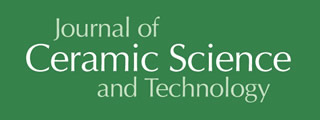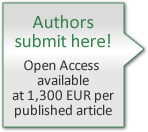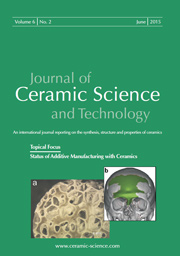Articles
All articles | Recent articles
Electrical Resistivity of Si3N4-SiC-MeSi2 (Me = Nb, Mo, W, Zr) Composites
E. Zschippang1, H. Klemm1, M. Herrmann1, S. Höhn1, B. Matthey1, U. Guth2, A. Michaelis1
1 Fraunhofer Institute for Ceramic Technologies and Systems, Winterbergstraße 28, D-01277, Dresden, Germany
2 Kurt-Schwabe-Institute for Measuring and Sensor Technology Meinsberg, D- 04720 Ziegra-Knobelsdorf, Germany
received April 15, 2013, received in revised form June 14, 2013, accepted June 28, 2013
Vol. 4, No. 4, Pages 197-206 DOI: 10.4416/JCST2013-00012
Abstract
Si3N4-SiC and Si3N4-SiC-MeSi2 (Me = Nb, Mo, W, Zr) composites were densified by means of hot pressing at 1840 °C. Additional heat treatment was performed at 1900 °C in a gas pressure furnace at 1900 °C. The hot-pressed and heat-treated composites were investigated with X-ray diffraction, scanning electron microscopy and measurements of their electrical resistivity. The electrical resistivity of the hot-pressed Si3N4-SiC composite was about 104 Ωcm. The addition of silicides yielded a decrease in composite resistivity to values of about 101-10-2 Ωcm. The subsequent heat treatment results in a further decrease of the resistivity by at least one order of magnitude for all composites. An α → β transformation in SiC was detected in the Si3N4-SiC-MeSi2 composites with XRD and electron backscatter diffraction (EBSD) analysis. The α → β transformation in SiC was strongly associated with a high-nitrogen doping concentration of the SiC grains, resulting in lower electrical resistivity of the Si3N4-SiC-MeSi2 composites in comparison with the Si3N4-SiC composite. Differences in the solution-precipitation process of SiC have been claimed as a reason for the highly doped SiC grains in the Si3N4-SiC-MeSi2 composites.
![]() Download Full Article (PDF)
Download Full Article (PDF)
Keywords
Electrical resistivity, silicon nitride, silicon carbide, α → β transformation, composite
References
1 Klemm, H.: Silicon nitride for high-temperature applications, J. Am. Ceram. Soc., 93, 1501 – 1522, (2010).
2 Manukyan, K.V., Kharatyan, S.L., Blugan, G., Kocher, P., Kuebler, J.: MoSi2-Si3N4 Composites: influence of starting materials and fabrication route on electrical and mechanical properties, J. Eur. Ceram. Soc., 29, 2053 – 2060, (2009).
3 Kao, M.Y.: Properties of silicon nitride-molybdenum disilicide particulate ceramic composites. J. Am. Ceram. Soc., 76, 2879 – 2883, (1993).
4 Guo, Z.Q., Blugan, G., Grauble, T., Reece, M., Kuebler, J.: The effect of different sintering additives on the electrical and oxidation properties of Si3N4-MoSi2 composites. J. Eur. Ceram. Soc., 27, 2153 – 2161, (2007).
5 Holleck, H.: Material selection for hard coatings, J. Vac. Sci. Technol., A4, 2661 – 2669, (1986).
6 Neshpor, V.S., Reznichenko, M.I.: Investigating the thermal expansion of some silicides, Refractories, 4, 145 – 148, (1963).
7 Klemm, H., Bales, A., Martin, H.P., Herrmann, M.: Electrically conductive ceramic composite (in German). DE 102006062371A1, (2006).
8 Sawaguchi, A., Toda, K.: Mechanical and electrical-properties of silicon-nitride silicon-carbide nanocomposite material, J. Am. Ceram. Soc., 74,1142 – 1144, (1991).
9 Yamada, K., Kamiya, N.: High temperature mechanical properties of Si3N4-MoSi2 and Si3N4-SiC composites with network structures of second phases, Mat. Sci. Eng. A-Struct., 261, 270 – 277, (1999).
10 Heuberger, M., Kuntz, M., Nass, R.: Silicon carbide element (in German), DE 19956767A1, (2001).
11 Willkens, C.A., Bateman, L.S.: Composition for small ceramic ignitors. US 005514630A, (1996).
12 Shor, J.S., Goldstein, D., Kurtz, A.D.: Characterization of n-type beta-SiC as a piezoresistor, IEEE T. Electron Dev., 40, 1093 – 1099 (1993).
13 Casady, J.B., Johnson, R.W.: Status of silicon carbide (SiC) as a wide-bandgap semiconductor for high temperature applications: A review, Solid-State Electronics, 39, 1409 – 1422, (1996).
14 Rost, H.J., Schulz, D., Siche, D.: High Nitrogen Doping During Bulk Growth of SiC. In: Silicon Carbide – Recent Major Advances. Springer-Verlag, Berlin Heidelberg New York, Germany, 2004.
15 Da Silva, A.F., Pernot, J., Contreras, S., Sernelius, B.E., Persson, C., Camassel, J.: Electrical resistivity and metal-nonmetal transition in n-type doped 4H-SiC, Phys. Rev. B, 74, 245201, (2006).
16 Alexander, M.N., Holcomb, D.F.: Semiconductor-to-metal transition in n-type group IV semiconductors, Rev. Mod. Phys., 40, 815 – 829, (1968).
17 Siegelin, F., Kleebe, H.J., Sigl, L.S.: Interface characteristics affecting electrical properties of Y-doped SiC, J. Mater. Res., 18, 2608 – 2617, (2003).
18 Kleebe, H.J., Siegelin, F.: Schottky barrier formation in liquid-phase-sintered silicon carbide, Z. Metallkd., 94, 211 – 217, (2003).
19 Kobayashi, R., Tatami, J., Wakihara, T., Komeya, K., Meguro, T., Tu, R., Goto, T.: Evaluation of grain-boundary conduction of dense AlN-SiC solid solution by scanning nonlinear dielectric microscopy, J. Am. Ceram. Soc., 93, 4026 – 4029, (2010).
20 Kondo, A.: Electrical conduction mechanism in recrystallized SiC, J. Ceram. Soc. Jpn., 100, 1225 – 1229, (1992).
21 Schroeder, A., Pelster, R., Grunow, V., Lennartz, W., Nimtz. G., Friederich. K.: Charge transport in silicon carbide: atomic and microscopic effects, J. Appl. Phys., 80, 2260 – 2268, (1996).
22 Clarke, D.R.: Varistor ceramics, J. Am. Ceram. Soc., 82, 485 – 502, (1999).
23 Pike, G.E.: Semiconducting polycrystalline ceramics. In: Materials Science and Technology. Wiley-VCH Verlag, 1994.
24 Haluschka, C., Engel, C, Riedel, R.: Silicon carbonitride ceramics derived from polysilazanes Part II. Investigation of electrical properties, J. Eur. Ceram. Soc., 20, 1365 – 1374, (2000).
25 Hebsur, M.G.: Development and characterization of SiC(f)/MoSi2-Si3N4(p) hybrid composites, Mater. Sci. Eng., A, 261, 24 – 37, (1999)
26 Samsonov, G.V: Handbook of refractory compounds. IFI/Plenum, New York, 1980.
27 Zschippang, E., Klemm, H., Herrmann, M., Sempf, K., Guth, U., Michaelis, A.: Electrical resistivity of silicon nitride – silicon carbide based ternary composites, J. Eur. Ceram. Soc., 32, 157 – 165, (2012).
28 Jeon, Y.S., Shin, H., Lee, Y.H., Kang, S.W.: Reduced electrical resistivity of reaction-sintered SiC by nitrogen doping, J. Mater. Res., 23, 1020 – 1025, (2008).
29 Jepps, N.W., Page, T.F.: The 6H-3C "Reverse" transformation in silicon carbide compacts, J. Am. Ceram. Soc., 64, C177 – C178, (1981).
30 Gnesin, G.G.: Karbidokremnievye materialy. Metallurgija, Moscow, 1977.
31 Ihle, J., Martin, H.P., Herrmann, M., Obenaus, P., Adler, J., Hermel, W., Michaelis, A.: The influence of porosity on the electrical properties of liquid-phase sintered silicon carbide, Int. J. Mater. Res., 97, 649 – 656, (2006).
32 Thorp, J.S., Sharif, R.I.: D.C. electrical properties of hot-pressed nitrogen ceramics, J. Mater. Sci., 13, 441 – 449, (1978).
33 Can, A.: Densification, microstructure and properties of liquid-phase sintered silicon carbide materials [PhD-Thesis]. University of Witwatersrand, Johannesburg, 2004.
34 Dietrich, I.: Measurement of the resistance of thin insulating layers between gold contacts in the range of the tunnel effect, (in German), Zeitschrift für Phys. A Hadron Nucl., 132, 231 – 238, (1952).
35 Kleebe, H.J.: Comparison between SEM and TEM imaging techniques to determine grain-boundary wetting in ceramic polycrystals, J. Am. Ceram. Soc., 85, 43 – 48, (2002).
36 Moberlychan, W.J., De Jonghe, L.C.: Controlling interface chemistry and structure to process and toughen silicon carbide, Acta Mater., 46, 2471 – 2477, (1998).
37 Pezzotti, G., Kleebe, H.-J., Ota, K.: Grain boundary viscosity of polycrystalline silicon carbides, J. Am. Ceram. Soc., 81, 3293 – 3299, (1998).
38 Tian, Z., Quick, N.R., Kar, A.: Laser-enhanced diffusion of nitrogen and aluminum dopants in silicon carbide, Acta Mater., 54, 4273 – 4283, (2006).
39 Kroko, L.J., Milnes, A.G.: Diffusion of nitrogen into silicon carbide single crystals doped with aluminium, Solid-State Electronics, 9, 1125 – 1134, (1966).
40 Dalaker, H., Tangstad, M.: Temperature dependence of the solubility of nitrogen in liquid silicon equilibrated with silicon nitride, Mater. T. JIM, 50, 2541 – 2544, (2009).
41 Narushima, T., Ueda, N., Takeuchi, M., Ishii, F., Iguchi, Y.: Nitrogen solubility in liquid silicon, Mater. T. JIM, 35, 821 – 826, (1994).
42 Herrmann, M., Goeb, O.: Colour of gas-pressure-sintered silicon nitride ceramics, part II. thermodynamic considerations, J. Eur. Ceram. Soc., 21, 461 – 469, (2001).
43 Kuhr, T.A., Liu, J., Chung, H.J., Skowronski, M., Szmulowicz, F.: Spontaneous formation of stacking faults in highly doped 4H-SiC during annealing, J. Appl. Phys., 92, 5863 – 5871, (2002).
44 Alexander, M.N.: Nuclear-Magnetic-Resonance study of heavily nitrogen-doped silicon carbide, Phys. Rev., 172, 331 – 340, (1968).
45 Kim, K.J., Lim, K.Y., Kim, Y.W.: Effective nitrogen doping for fabricating highly conductive b-SiC ceramics, J. Am. Ceram. Soc., 94, 3216 – 3219, (2011).
46 Villars, P., Okamoto, H., Cenzual, K.: A-B-C phase diagram, ASM Alloy Phase Diagrams Center, ASM International, Materials Park. http://www1.asminternational.org/AsmEnterprise/APD 2006.
Copyright
Göller Verlag GmbH


